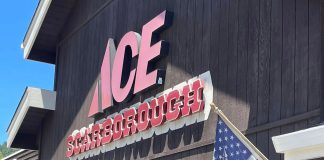What’s one thing you can do to improve your health, reduce your impact on global warming, increase food security in your community, help the local economy and rediscover the pleasures of good eating? It’s simple: Eat locally grown or raised food.
Whether you buy Brussels sprouts grown along the Santa Cruz County coast or gather eggs from chickens grazing in your backyard, supporting local agriculture has more benefits to you and your community than you may realize. And, in many cases, it even tastes better. Broccoli, for example, begins losing its flavor and crisp texture (as well as its nutrients) quickly after harvest; anyone who has ever grown their own broccoli would agree.
It’s also important to consider the amount of oil that goes into the shipping of food from far-off places — how expensive will those springtime Argentinean pears be when oil tops $150 a barrel? And how long can this relationship continue?
As San Lorenzo Valley residents, we’re fortunate that the local school district has been proactive in getting fresh, organic, locally grown food into school lunches. I recently spoke with local mother and author Sue Kuivanen (“Parent’s Diet Handbook: A Mother and Daughter’s Journey in a Junk Food Society”), who volunteers with the district’s Student Nutrition Services.
When she first began working with the lunch program, she said, most of the meals were pre-processed and simply reheated. The full-size kitchen was underused. Now, most lunches are made fresh from whole ingredients. A partnership with Shumei Santa Cruz Farm in Bonny Doon allowed the district to procure local, organic produce at a low cost.
The shift to more locally grown food in school lunches gained steam with the formation of SLV Locals, made up of parents, teachers, staff members and board members who wanted to feed the students healthier meals while strengthening the lunch program fiscally.
“We all understood that we live in a bit of an agricultural heaven, and if anywhere kids should be eating fresh, locally grown foods, it ought to be happening in the Santa Cruz area,” Kuivanen said.
The schools still serve pizza once a week, since it’s a strong money-maker, but instead of being pre-packaged, it’s made fresh by a local pizzeria.
Still, getting children to choose the healthier option remains challenging — especially where vegetables are concerned.
“We can bring fresh, green salads to the kids, but many of them won’t eat it,” she said.
She remains hopeful that on-site school gardens will encourage youngsters to try different types of vegetables they might otherwise avoid.
The SLE Life Lab garden program, in conjunction with University of California, Santa Cruz, provides kindergarten through third-grade students with hands-on instruction and curriculum to teach them about gardening and healthy eating habits. San Lorenzo Valley Elementary and Boulder Creek Elementary both have their own on-site, organic vegetable gardens as the basis of their respective Life Lab programs. The Life Labs are operated primarily through parent fundraising efforts, so donations are always appreciated.
Kuivanen, Student Nutritional Services director Kimberly Clark and other volunteers hope the lunch program can sustain itself without the need to borrow money from the school district’s general funds. The best way to support the program is to use the program, particularly on Natural Foods Wednesdays, which showcase the best organic fruits and vegetables Santa Cruz County has to offer.
Meals cost $3 and can be purchased through a pre-paid account. Visit www.slv.k12.ca.us/nutrition for more details.
Steve Tanner is a writer living in Ben Lomond with his wife and two young children. He is an active member of Transition San Lorenzo Valley, a local nonprofit group committed to creating a more sustainable and resilient community.











